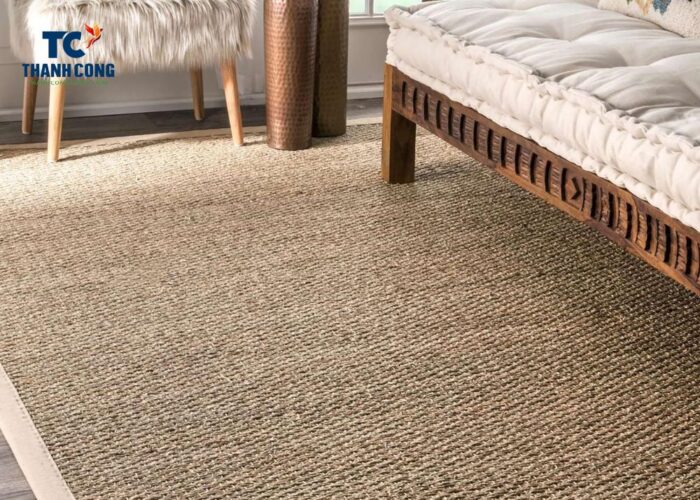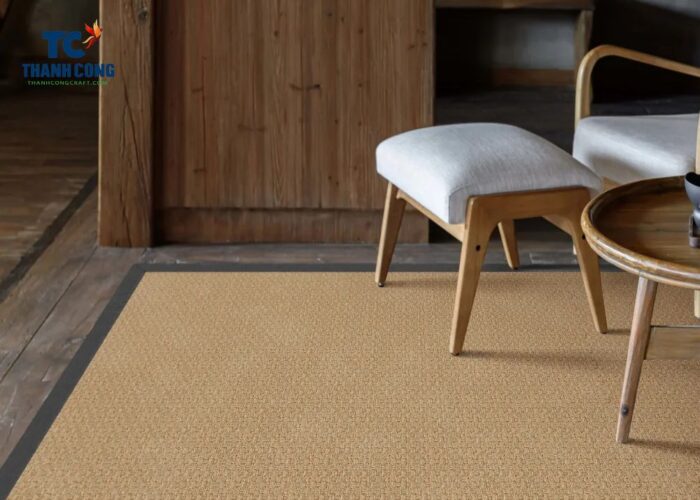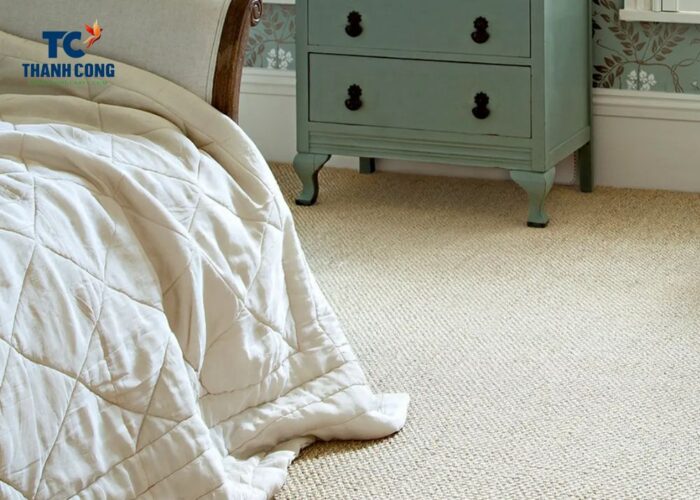Seagrass carpets (seagrass rugs) have many advantages such as durability, comfort, environmental friendliness and reasonable price. However, a seagrass carpet also has some disadvantages such as being difficult to clean, not resistant to moisture and not having many colors to choose from.
In this article, we will introduce you to seagrass carpets pros and cons so that you can decide whether they are suitable for your living space or not.
Contents [hide]
1. Seagrass Carpets Pros And Cons
Seagrass carpets/ rugs are a type of carpet made from natural seagrass fibers, which have many advantages such as durability, comfort, environmental friendliness and affordability.
They are often used to create interior products, wall to wall carpet, use in bedrooms or make intriguing wall to wall partitions for a truly interesting living space.
Seagrass carpets are primarily used as a flooring or wall to wall material. They provide a natural and rustic look to indoor spaces like bedroom, living room. That makes them a popular choice for a relaxed, natural aesthetic space.

However, seagrass carpets also have some drawbacks such as being difficult to clean, not water-resistant and having limited color options.
In this article, we will analyze in detail the pros and cons of seagrass carpets so that you can decide whether they are suitable for your living space or not.
1.1 Seagrass Carpets’s Pros
Seagrass carpets offer a plethora of advantages, making them a popular and environmentally friendly choice for flooring solutions. One of the key benefits lies in their natural and sustainable origin. Seagrass is a renewable resource that grows in coastal areas, making it an eco-friendly alternative to synthetic carpet materials.
Durability is a standout feature of seagrass carpets. The fibers are robust and resistant to wear, ensuring that the carpet remains in good condition even in high-traffic areas. This durability not only means fewer replacements over time but also represents a wise investment for homeowners.
Another key benefit is the natural stain resistance of seagrass carpets. The inherent waxy coating on the fibers acts as a protective shield, making it difficult for liquids and dirt to penetrate. This feature is particularly advantageous in households with children or pets, where spills are more likely to occur.

Another “pros” of seagrass carpets is that they can contribute to the aesthetic appeal of a space. With their neutral tones and natural texture, they can complement a variety of interior design styles, providing a timeless and elegant look. The addition of a seagrass carpet can add warmth and depth to a room, enhancing its overall ambiance.
For those with allergies or sensitivities, seagrass carpets offer a hypoallergenic option. Unlike some synthetic materials, seagrass does not trap dust or promote the growth of mold and mildew, making it a healthier choice for indoor environments.
Seagrass carpets are straightforward to maintain as they resist attracting dust or dirt. Regular vacuuming or sweeping is effective, and in case of spills, they can be easily spot cleaned with a damp cloth or sponge. Moreover, these carpets possess antibacterial properties, acting as a deterrent against the growth of mold and mildew.
In addition to their practicality, seagrass carpets are among the most budget-friendly options in natural flooring. Despite their low cost, they deliver a high-quality aesthetic and tactile experience. Furthermore, seagrass carpets come in a diverse range of designs and patterns, catering to various tastes and styles.
In conclusion, the pros of seagrass carpets encompass their eco-friendly nature, durability, natural stain resistance, aesthetic versatility, and hypoallergenic properties. Choosing seagrass as a flooring option is not just a practical decision but also a stylish and conscientious one for creating a comfortable and sustainable living space.
1.2 Seagrass Carpets’s Cons
What are the disadvantages of seagrass? Seagrass carpets have many advantages such as durability, comfort, environmental friendliness and affordability. However, seagrass carpets also have some drawbacks that consumers need to be aware of when using them.
One notable concern is their susceptibility to moisture. Seagrass is a natural fiber that can absorb water, leading to discoloration or warping if exposed to excessive humidity or spills. This makes seagrass carpets less suitable for areas prone to high moisture levels, such as bathrooms for basements.
Another disadvantage is the sensitivity of seagrass to direct sunlight. Prolonged exposure to sunlight can cause fading and degradation of the fibers over time. Therefore, seagrass carpets may not be the best choice for rooms with abundant natural light, unless appropriate measures like using window treatments are taken to minimize sun exposure.

Although seagrass carpets are relatively durable, they may not be as soft underfoot as some synthetic alternatives. The natural texture of seagrass can be coarse, and this might be less comfortable for those who prefer a softer feel in their flooring. In spaces where comfort is a priority, such as bedrooms or living rooms, supplementing seagrass carpets with additional rugs or padding could be considered.
Furthermore, seagrass carpets are less forgiving when it comes to stains compared to synthetic materials. While they have some inherent resistance, they may still be more challenging to clean in the event of a stubborn stain. They need to be treated immediately with specialized products or call professional cleaning services.
Another drawback of seagrass rugs is that they are not suitable for every space. Seagrass carpets have natural green or brown colors, without much choice in terms of colors and patterns. Therefore, seagrass carpets may not match the decoration style of some houses.
In conclusion, assessing these factors in relation to the specific needs and preferences of a given space is crucial when determining whether seagrass carpets are the right choice for a particular environment.
2. FAQs
2.1 Is seagrass carpet good for pets? pros and cons
Seagrass has many pros for pets such as: durable, non-toxic, easy to clean, and with a natural texture for your pets to scratch, which can help divert their attention away from other pieces of furniture.
However, seagrass also has some disadvantages when used for pets, such as:
- Seagrass can be prone to staining from pet accidents such as urine, vomit, and saliva, etc.
- Seagrass carpets can be sensitive to moisture and may develop mold or mildew if exposed to excessive dampness, potentially posing health risks to your pet.
- While seagrass can be appealing to pets for scratching, it can also get damaged in the process. Over time, your seagrass carpet may exhibit signs of wear from pet claws
Therefore, when using seagrass for pets, you should choose the size, shape and color that suits your living space and pets; place the rug in places with less contact with water; and check the condition of the rug regularly to ensure safety and health for you and your pets.
2.2 Is seagrass rug durable? How long does seagrass carpet last?
Seagrass rug is a type of carpet made from natural seagrass fibers, which have high durability and moisture resistance.
Seagrass rugs can be used in various spaces, from living rooms, bedrooms, to kitchens or bathrooms. Seagrass rug is also easy to clean and maintain, just need to vacuum regularly and wipe gently when dirty.
The lifespan of seagrass carpet depends on many factors, such as the quality of the seagrass fibers, the design and sewing of the carpet, as well as the usage and maintenance of the user.
However, seagrass carpet can last from 5 to 15 years, if properly cared for. Some tips to extend the life of seagrass carpet are to avoid exposing the carpet directly to sunlight, avoid leaving the carpet wet for too long, and avoid using strong detergents.
2.3 Are seagrass rugs comfortable?
The answer to the question: are seagrass rugs comfortable? may depend on many factors, such as personal preference, purpose of use and environmental condition.
- Personal preference: If you like a soft, cozy and warm rug, then a seagrass rug may not be the best choice for you. If you like natural fiber rugs, sturdy and easy-to-clean rugs, then seagrass rugs may be a reasonable option.
- Purpose of use: If you want to use seagrass rug for living room, seagrass carpet bedroom or children’s room, you may need to pay more attention to its comfort and safety. If you want to use seagrass rug for dining room, kitchen or balcony, you may care more about its durability and easy maintenance.
- Environmental condition: If you live in a place with a humid, hot or cold climate, you may need to pay attention to the heat and moisture resistance of seagrass rugs. If you live in a place with a dry, mild or cool climate, you may not need to worry much about this issue.
Thus, the answer to the question “are seagrass rugs comfortable?” is not right or wrong, but depends on the needs and conditions of each person. You can refer to other sources of information to get diverse opinions and choose the best option for yourself.
In conclusion, delving into the seagrass carpets pros and cons reveals a dynamic interplay of advantages and considerations. By carefully considering the specific needs of your space and lifestyle, you can determine whether the pros outweigh the cons, ensuring that your choice of seagrass carpets aligns seamlessly with your vision for a harmonious and environmentally conscious home.


